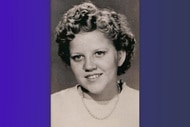Create a free profile to get unlimited access to exclusive videos, breaking news, sweepstakes, and more!
Anchorage John Doe From 1989 Identified As Michael Beavers, Missing Since 1980
Michael Allison Beavers, who was reported missing in 1980, was identified more than three decades after his unidentified body was found on the shore of an uninhabited island.

An Alaska man, whose identity remained a mystery for more than 32 years after his body turned up on the shoreline of an uninhabited island west of Anchorage, was identified this month, state authorities said.
Michael Allison Beavers, a former heavy equipment operator from Chugiak, Alaska first reported missing in 1980, was identified as the suspected murder victim whose identity baffled investigators for decades.
On July 24, 1989, a decomposing body was found on a northwest shore of Anchorage's Fire Island, an uninhabited site with no physical connection to the mainland. A preliminary autopsy indicated the victim was a white man estimated to be between 35 and 50 years old; foul play was suspected but an approximate date of death was never accurately determined.
According to an anthropologist, the man's body had been lying exposed on the beach for at least one year. He was ultimately interred at the Anchorage Municipal Cemetery, officials said.
In 2003, hair and tissue samples, which had been preserved during the initial autopsy, were sent to an FBI laboratory in Virginia and forensic experts developed a mitochondrial DNA profile. The genetic material was later uploaded into a national missing person’s database, but no matches were returned.
The Alaska Bureau of Investigation Cold Case Investigation Unit revived the investigation into the John Doe's death in 2021. Texas-based private DNA laboratory, Othram Inc. was also approached to assist investigators in analyzing bone samples provided by the State Medical Examiner’s Office. The lab, which uses Forensic-Grade Genome Sequencing, ultimately developed an advanced DNA profile for the man, which was later entered into a genealogy database. He was preliminarily linked to relatives of the long-missing Michael Beavers.
State troopers then tracked down blood relatives of Beavers’ and gathered further DNA samples, which ultimately confirmed his identity.
Beavers, who worked as a heavy equipment operator, was 41 at his time of death. He had owned an excavation business in Chugiak, roughly 29 miles north of where his remains were found in 1989.
Beavers was reported missing by his wife in January 1980, but was last seen alive months earlier. Officials said Beavers had embarked on a business road trip to Seattle in November 1979, but never made it to Washington state. Investigators, who were unsuccessful in developing any concrete leads into Beavers' disappearance, closed his missing persons case in 1982.
"Because of the hard work of Investigators, analysts, the Alaska State Crime Lab, the FBI Laboratory in Virginia and genealogy research by Othram Inc., Michael Beavers was identified 43 years after his body was found," Timothy DeSpain, a public information officer for the Alaska Department of Public Safety, told Oxygen.com. "The Department of Public Safety is now seeking information about the final days before Beavers’ disappearance and murder, to bring to justice those responsible."
This is not the first case Alaska law enforcement has solved with the assistance of new DNA technology.
In October of this year, the Alaska Bureau of Investigation announced it had also identified cold case murder victim, Robin Pelkey — otherwise known as “Horseshoe Harriet” — who was murdered by serial killer Robert Hansen in the early 1980s. The identification, made by Parabon Nanolabs in collaboration with state authorities, incorporated similar advancements in DNA technology used to identify Beavers.
In recent years, the company that helped identify Beavers, Othram Inc., has also assisted authorities across the country in solving several cold case homicides using their patented genome sequencing technology.
"It’s essential to address what the National Institute of Justice calls the 'silent mass disaster' of the tens of thousands of unidentified persons in our country,” David Mittelman, the CEO and founder of Othram Inc. said in a statement sent to Oxygen.com on Friday.
“The primary mission is to reconnect the missing and unidentified to family. However, many of these unidentified, including Michael Beavers, are victims of crimes and identifying them allows for justice to be sought out on their behalf. It is a key mission at Othram to build and scale technology that can allow all agencies to work through their backlogs of unidentified remains."
Earlier this week, Las Vegas Metropolitan Police Department announced that Othram Inc. had helped identify the murder suspect in the previously unsolved rape and killing of Kim Bryant, a 16-year-old who vanished from a Vegas-area Dairy Queen in 1979.
“The immediate reward is that we can help solve these cases and put these families back together,” Mittelman told Oxygen.com about that case. “These families are tortured by unsolved crime.”
Anyone with additional information regarding Beavers’ case is encouraged to contact the Alaska Department of Public Safety’s Cold Case Investigation Unit at 907-269-5038 or 800-478-9333. Tips can also be submitted via email at dps.missing.persons@alaska.gov.


























